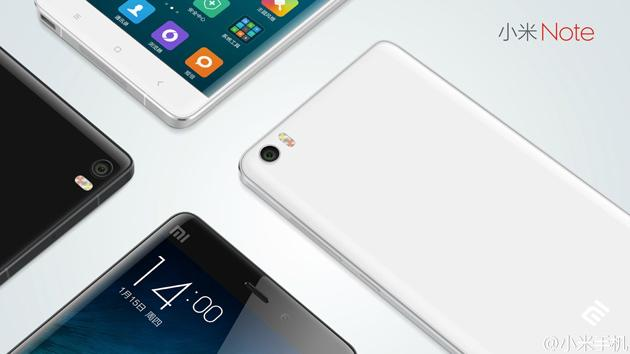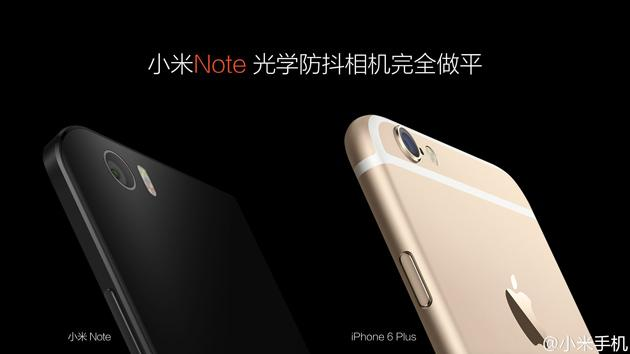Xiaomi take on Apple with its own phablet with similar design
Not content with growing at a record pace, the Chinese IT startup now wants to take Apple on with a new phablet that will dwarf the success of their Redmi 2 with its 4.7-inch screen, 4G LTE connectivity, and impressively low price.
The 5.7-inch MiNote takes its look from the latest iPhone 6 Plus with curved edges and Gorilla Glass 3 on both sides which is described as 2.5D curved on the front and 3D curved on the back. Just 6.95mm thin, weighing in at a light 161 grams for a phablet, and sporting an aluminum alloy frame, the MiNote came to be noticed.
The Android operating system included has a Xiaomi skin which adjusts the language and look of the operating system to make it cleaner, flatter with more eye-popping colors evident throughout.
Two Display Choices
There are two versions of the MiNote. The first is their standard version which possesses a NTSC color gamut rating of 95 percent to ensure that almost all colors and shades will be displayed accurately. The display screen is from either Sharp or JDI with a 1080p resolution. The Pro model will be released later and come with a Quad HD 1440p display sporting an insane 515 ppi.
Two Specifications
The base model includes the 2.5GHz quad-core Qualcomm Snapdragon 801 chip with snappy Adreno 330 graphics processor. This is an older SnapDragon chip but still quite capable in its own right. A generous 3GB RAM (LPDDR3) is included which will power many open apps are once. The 3,000mAh battery is in keeping with models like the Samsung Galaxy Note 4 LTE and comes with the Quick Charge 2.0 for faster recharging. Internal storage is either a minimal 16 GB or a more reasonable 64 GB. This model comes in either black or white colors.
The Pro model offers the Quad HD screen with its 1,440 ppi, the latest Qualcomm 2GHz octa-core Snapdragon 810 combined with Adreno 430 graphics processor. A full 4GB RAM (LPDDR4) is included of faster RAM which represents extreme memory capacity for a phablet in the current market (Samsung Galaxy Note 4 has 3 GB of RAM). 64GB of internal storage is included. The 4G LTE Cat 9 (maximum downstream of 450Mbps) future-proofs the 4G LTE abiltiy as few cellular carriers have even launched a category 9 capable 4G LTE network yet. The battery is fractionally larger at 3,090mAh. The model is offered in gold color only.
Gorilla Glass 3 Front and Back
It is unusual for a smart phone to be covered in the latest Gorilla Glass 3 on both sides of the unit. Perhaps because of this the phone company is offering an annual insurance policy at CN 199 to cover for screen damage, glass damage on either side of the device, plus accidental liquid damage which is a nice extra to have. Xiaomi have also been running their own drop tests to ensure the model is robust enough.
Cameras with Dual Color LED
There is a rear-facing 13 megapixel camera f/2.0 with optical image stabilization to help people with a less than steady hand taking family shots. There is a dual color LED flash which was developed by Philips that may please those people who want a better flash option. Alternatively, the latest Lenovo flash accessory might be of interest too. On the front is a generous 4 megapixel shooter that is said to be “large pixel” and shares much of the same technology from the respected UltraPixel imager from HTC.
For the camera specifics, the 13 megapixel rear-facing camera only uses 1.12-micron pixels so the quality isn't expected to be fantastic (HTC UltraPixel is 2 micron). By comparison, the iPhone 6 series possesses an 8 megapixel sensor using 1.5-micro pixels which likely take smaller, clearer shots.
Audio Goes HiFi
The audio gets a considerable boost with the inclusion of the HiFi Sabre ES9018K2M high-end DAC. In addition there is the Analog Devices' ADA4896 and Texas Instruments OPA1612 as audio amplifiers. Audiophiles are sure to notice the difference in the sound quality here.
Lossless audio formats are supported with the MiNote to help with audio sound performance. Lossless FLAC, APE, WAV and DSD audio formats will all perform flawlessly. Xiaomi also offer 50mm headphones for approximately $80 if buyers are not happy with other market alternatives to get the best out of their HiFi system.
Competitive Pricing
Perhaps what will appeal more though is the price. Starting at $370 or CN 2,299 as a base price for the standard model with 16 GB internal storage (and $450 for the 64 GB model, without a contract, the price is highly competitive in the Chinese market compared to other models with a similar specification.
The more advanced Pro version is more expensive at $530 but comes with a specification built for more speed, extra storage and that category 9 4G LTE radio.
Release Dates
The Sharp / JDI version with the 1080p display is due for release on January 27 with the Quad HD 1440p display Pro version being released later in March.
How Does The MiNote Pro Stack Up Against The iPhone 6 Plus
The MiNote exceeds what is offered with the current Samsung Galaxy Note 4 LTE model. It is also is sure to give the iPhone 6 Plus a run for its money at a lower price. Sporting the very latest Qualcomm SnapDragon 810 SoC, there will not be much in speed between the Pro MiNote model and the iPhone 6 Plus. Other specifications are quite similar as well making the consumer choice a difficult one that comes more down to the operating system, app market size, and price rather than phone differences.



